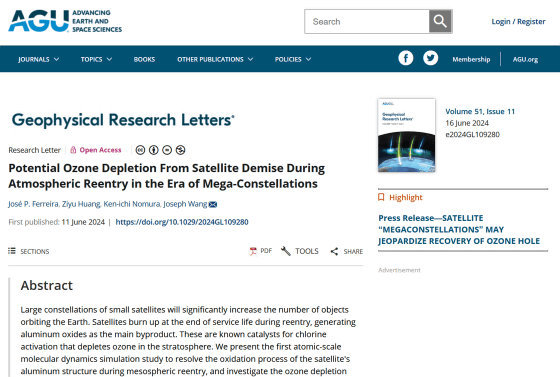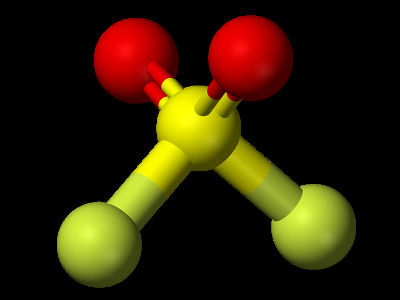If the number of artificial satellites such as SpaceX's satellite internet 'Starlink' increases rapidly, the ozone layer that protects the Earth may be destroyed

Potential Ozone Depletion From Satellite Demise During Atmospheric Reentry in the Era of Mega‐Constellations - Ferreira - 2024 - Geophysical Research Letters - Wiley Online Library
https://agupubs.onlinelibrary.wiley.com/doi/10.1029/2024GL109280

Satellite 'megaconstellations' may jeopardize recovery of ozone hole - AGU Newsroom
https://news.agu.org/press-release/satellite-megaconstellations-burn-deplete-ozone/
Satellite constellations like Elon Musk's Starlink could deplete Earth's ozone layer, study says | The Independent
https://www.independent.co.uk/space/elon-musk-spacex-starlink-internet-b2565081.html
The ozone layer is important for protecting the Earth, but in the 20th century, it was discovered that chlorine -containing compounds such as fluorocarbons, which are used as refrigerants for refrigerators and air conditioners and as cleaning agents for printed circuit boards, were destroying the ozone layer, which became a major social issue. In recent years, the ozone layer has been showing signs of recovery due to the restrictions on emissions of fluorocarbons and other gases based on the Montreal Protocol .
However, a new paper published by a research team at the University of Southern California School of Engineering points out that the rapid increase in 'low-Earth orbit artificial satellites' could destroy the ozone layer that has been so well restored.

Of the roughly 8,100 satellites in low Earth orbit, about 6,000 have been launched by SpaceX in the past few years to operate the satellite internet service
These satellites deployed in low Earth orbit for satellite internet have a short lifespan of about five years, so companies must continue to launch satellites to provide services. When a satellite reaches the end of its useful life, it re-enters the Earth's atmosphere and burns up, releasing contaminants that remain in the atmosphere. Most research on satellite pollution to date has focused on rocket fuel during launch, and little attention has been paid to the contaminants released when the satellite burns up.
The team therefore modelled the chemical composition and bonding of the materials that make up the satellite to investigate what type of contamination would occur during atmospheric re-entry. They found that a typical 250 kg satellite, with 30% of its mass being aluminium, would produce around 30 kg of aluminium oxide nanoparticles when it burned up during atmospheric re-entry. It is estimated that most of the aluminium oxide nanoparticles are produced in the mesosphere, 50-85 km above the Earth's surface, and can take up to 30 years to reach the stratosphere, where 90% of the ozone layer is located.
A total of about 17 tonnes of aluminium oxide nanoparticles will be produced by burnt-out satellites in 2022. When all planned satellites are deployed, the amount will reach 360 tonnes per year, which is 646% higher than natural levels in the atmosphere.
'Aluminum oxide does not chemically react with ozone molecules by itself, but it does trigger destructive reactions between ozone and chlorine. Because aluminum oxide is not consumed by these chemical reactions, it will continue to destroy ozone molecules floating in the stratosphere for decades to come. For these reasons, the research team warns that the increase in artificial satellites could cause significant ozone depletion.'

'Only in recent years has it been thought that contamination from burnt-up satellites might be an issue, and we were one of the first teams to look at what these facts mean,' said Joseph Wang, a co-author of the paper and professor of astronautics at the University of Southern California.
Related Posts:
in Science, Posted by log1h_ik







